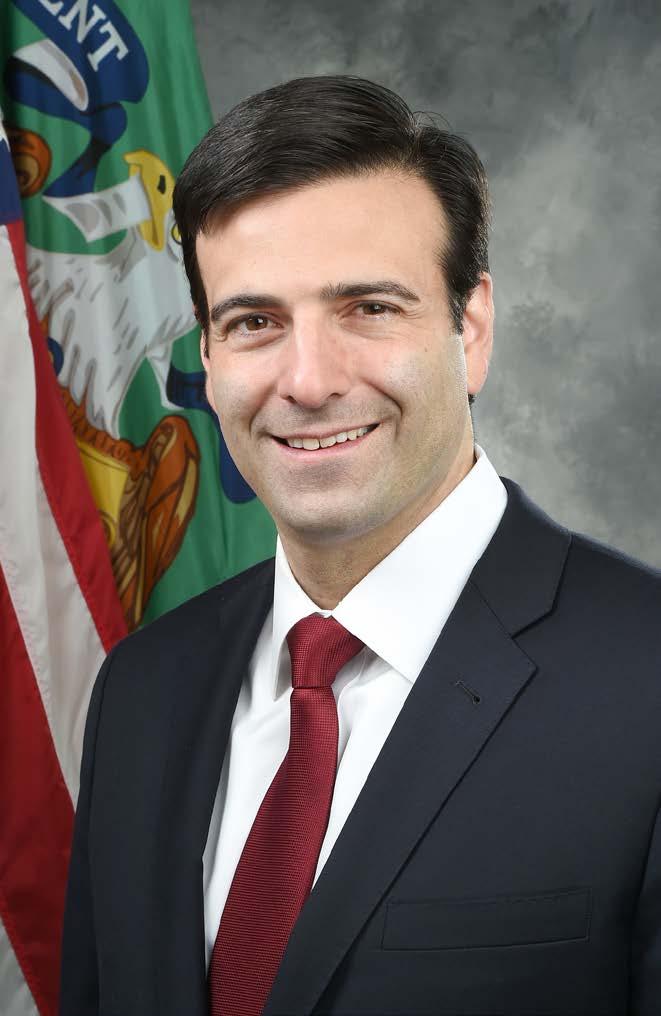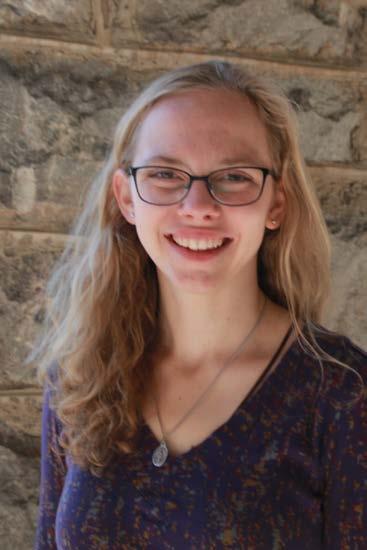
10 minute read
IN THEIR FOOTSTEPS
By Donna Klinger
SETTLE INTO ONE OF THE COMFORTABLE CHAIRS IN THE CATHOLIC STUDIES ROOM on the second floor of Phillips Library with books from the Archives that trace Mount St. Mary’s University’s illustrious 210-year history perched on your lap. As you peruse the historic records, let your mind see flashing images and hear the voices of the towering greats, including two saints, a martyr, two United States presidents and a founder, who have walked and left their indelible mark on this bucolic campus.
Rev. John DuBois
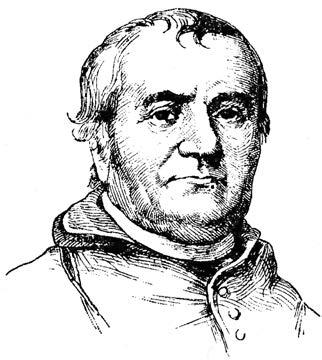
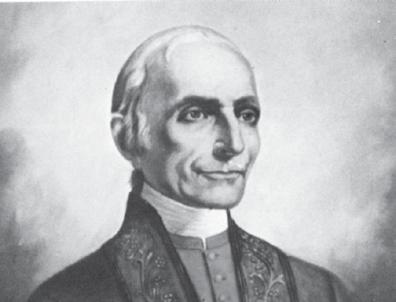
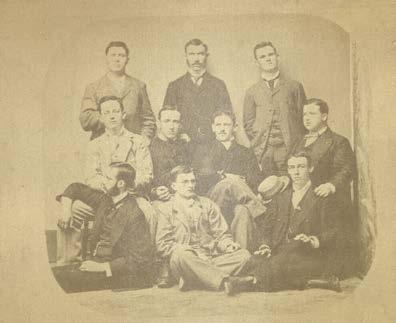
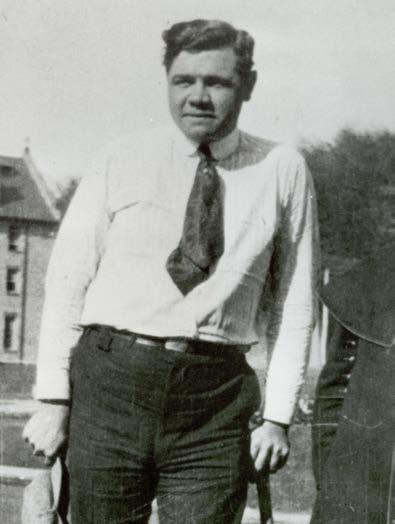
Rev. Simon Gabriel Bruté On an unseasonably warm day in October 1808, the 44-year-old Rev. John DuBois removed his coat, rolled up his sleeves and labored with his parishioners and members of the community to lay the foundations of what would become Mount St. Mary's University. Rather than building next to Saint Mary on the Hill, the church that he had erected in the verdant grotto on the mountain to serve a burgeoning Catholic population, DuBois, a refugee from the French revolution and a circuit-riding priest, located the school on the expansive plateau at the base of the hill. The campus continues to be protected by Mary's Mountain from the north and west winds and to bask in brilliant sunshine, dappled by the shadows from the broad belt of trees encircling the area. DuBois, the school’s first president, and his small cadre of faculty, which included the Right Rev. Simon Gabriel Bruté as of 1812, offered a full and rigorous high school and college curriculum to both potential clerics and local boys. U.S. President William Henry Harrison and a funeral march for the Marquis de Lafayette. The Mount quickly earned a reputation as a producer of bishops. Among early graduates of the seminary were John McCloskey, the first American cardinal; John Hughes, first archbishop of New York; John Purcell, first archbishop of Cincinnati; William Quarter, first bishop of Chicago; George Carroll, first bishop of Covington, Kentucky; Richard Whelan, first bishop of Wheeling, West Virginia; and Francis Gartland, first bishop of Savannah. Today, Mount St. Mary’s Seminary claims 52 episcopal alumni. Early student life revolved around academics and religious development, with few student organizations. The early college limited recreation for students to Wednesday and Saturday afternoons and condoned walking the grounds only. Six professors taught a core curriculum that took seven years to complete and offered no specialization.
The Class of 1880
Babe Ruth Bruté, known as the “Angel of the Mount,” served as teacher and pastor, as well as spiritual director to the future saint, Elizabeth Ann Seton. Church officials worldwide sought Bruté’s counsel for he was not only lauded for his unselfishness and spirituality, but also his immense erudition. He loved nature, declaring that the “Hills (of Mount St. Mary’s) shall be girded about with joy.” On Sunday afternoons, Mother Seton, seated on her own special rock, taught Christian Doctrine to the children of the Mountain Parish before they all drank from a neighboring spring and rambled at the picturesque grotto. DuBois and Bruté eventually left their beloved mountain home to become bishops of New York and Vincennes, Indiana, but not before establishing the Mount as a university that taught the men who served selflessly to shape the nation and the Church. Students during this time included Dr. William Whelan, who served as surgeon general of the U.S. Navy during the Civil War, and renowned artist John La Farge. Students were taught by nationally renowned faculty. Early professors included the Rev. Charles Constantine Pise, who is still the only Catholic priest to serve as chaplain of the U.S. Senate; George Henry Miles, a nationally renowned poet and dramatist; and Henry Dielman, a notable composer who was the first person in the United States to receive a doctorate in music. Among Dielman's many achievements are the inauguration march for
A NOBLE TREE President John McCaffrey opened the Jubilee Celebration in 1858 by reflecting on the college’s growth: “The seed they planted then—the seedling, which they nursed and watered with their sweat and tears—is now indeed a noble tree, whose fruits are known, and not unhonored, throughout the world.” Four years later, war came to the college as the Mount community heard the sounds of the Battle of South Mountain. Within a year troops passed through the Mount on their way to Gettysburg. As the war raged on, many students from the South left the college to join the Confederate Army. At least one Confederate soldier haunts the Mount, according to the ghost stories told by the late Rev. Daniel C. Nusbaum, Ph.D., a long-time and well-loved professor and college historian. The soldier, killed at Gettysburg, was buried face down in an old well, preventing him from seeing the star that he and his beloved had agreed to gaze at each night as they thought about each other. The spirit reportedly taps Mounties on the shoulder, begging them to “turn me over.” The Mount’s sturdy and noble tree continued to bear fruit in the 1900s. The crack of Babe Ruth’s mighty bat resounded on Echo Field on two occasions. Tradition holds that he was discovered in a game between his team from a Baltimore industrial school and the Mount. While the roar of the crowd no longer blows the roof off Memorial
Senator Robert Kennedy
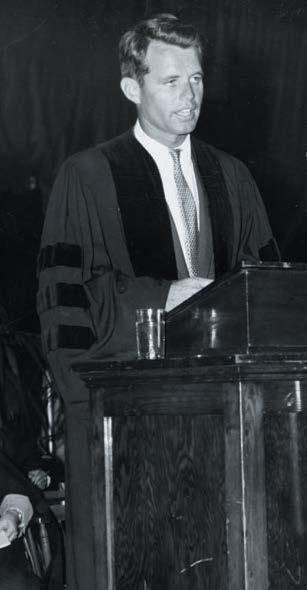
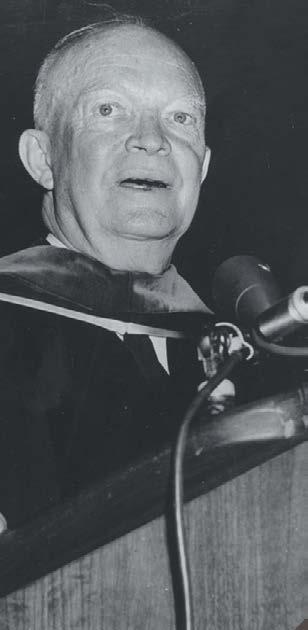
Gym, most memorably in 1962 when legendary men’s basketball coach Jim Phelan led the Mount to its first NCAA Division II Championship, the whoosh of the ball cutting through the net can still be heard during the men’s basketball team practices in the converted war surplus steel hangar. For more than 60 years, Memorial Gym has stood as a reminder of the 17 alumni who died in World War I and the 28, including three chaplains, who were killed in World War II. At least 727 Mountaineers joined the armed forces during World War II, 48 of them as chaplains.
President Dwight D. Eisenhower The buzz of aircraft became a familiar sound during World War II when the college combatted declining enrollment by initiating a CAA-War Training Service School for flying specialists. A Navy V-12 deck officers’ school was established, bringing nearly 400 men to the empty classrooms, overseen by Rev. Carl J. Fives, who served the Mount for more than 60 years as a student, seminarian, faculty member and administrator. In honor of its service to the armed forces training programs, the college received a 3-inch/50-caliber anti-aircraft gun from the USS Detroit—a ship credited with one downed and one assisted downed aircraft during the battle at Pearl Harbor. In the late 1970s and early 1980s, each graduating class painted the gun in its own colors and with its own slogans as part of its departing ritual.
Msgr. Hugh Phillips and the Blessed Mother statue now atop the Campanile
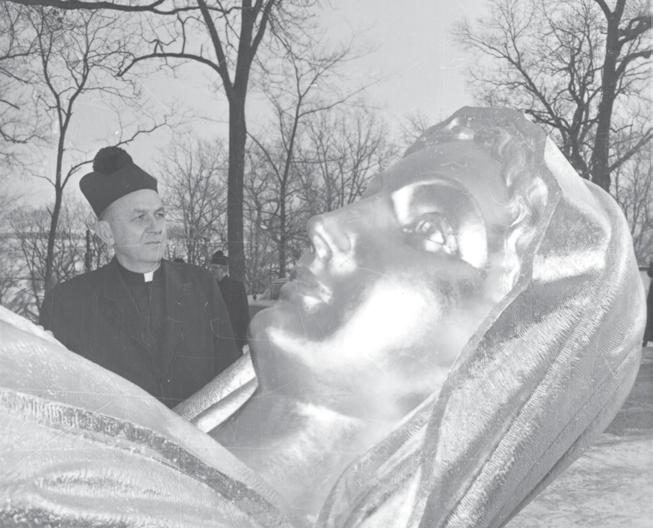
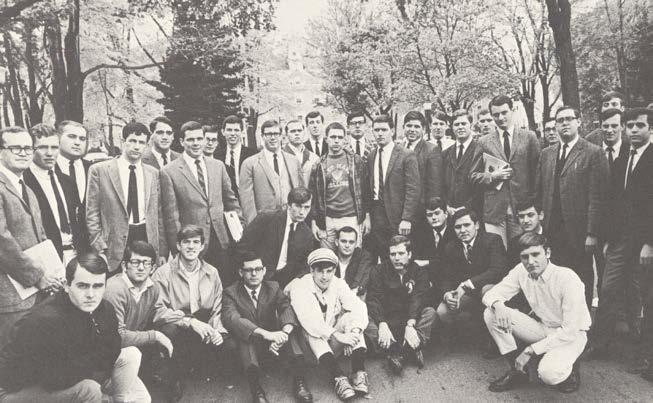
Class of 1968
LIMITLESS POSSIBILITIES Highlights of the sesquicentennial celebrations in 1958 were visits from Senator Robert Kennedy and President Dwight D. Eisenhower, who gave the commencement address. “I personally think that the traditions of the religiously oriented colleges become more and more important,” Eisenhower said. “…the core of the struggle between the free and the despotic world today is that between a religious faith and an atheistic dictatorship. If that is true, then I can see no limits to the possibilities of this type of college, where faith in our God is put at the very cornerstone of all that we hope to achieve—all America, or any one of us individually.” This consequential year also saw the naming of the National Shrine Grotto of Our Lady of Lourdes as a public oratory and national shrine, in the same year that Msgr. Hugh Phillips was tapped as director and Grotto chaplain. After overseeing the restoration of the shrine, Phillips opened it to the public. He also added the Pangborn Memorial Campanile crowned with a 25-foot, gold-leafed bronze figure of the Virgin Mary and other statuary monuments throughout the grounds. In the early 1960s, Blessed Stanley Rother, S’63, the first formally recognized American-born martyr who refused to abandon his faith community in Guatemala, despite death threats and his eventual murder, helped to build the National Shrine Grotto’s rock wall when he was a seminarian. The Mount was “something very influential in [Rother's] own spiritual life," said Rev. Ted Trinko, chaplain at the National Shrine Grotto.
Saint Teresa of Calcutta
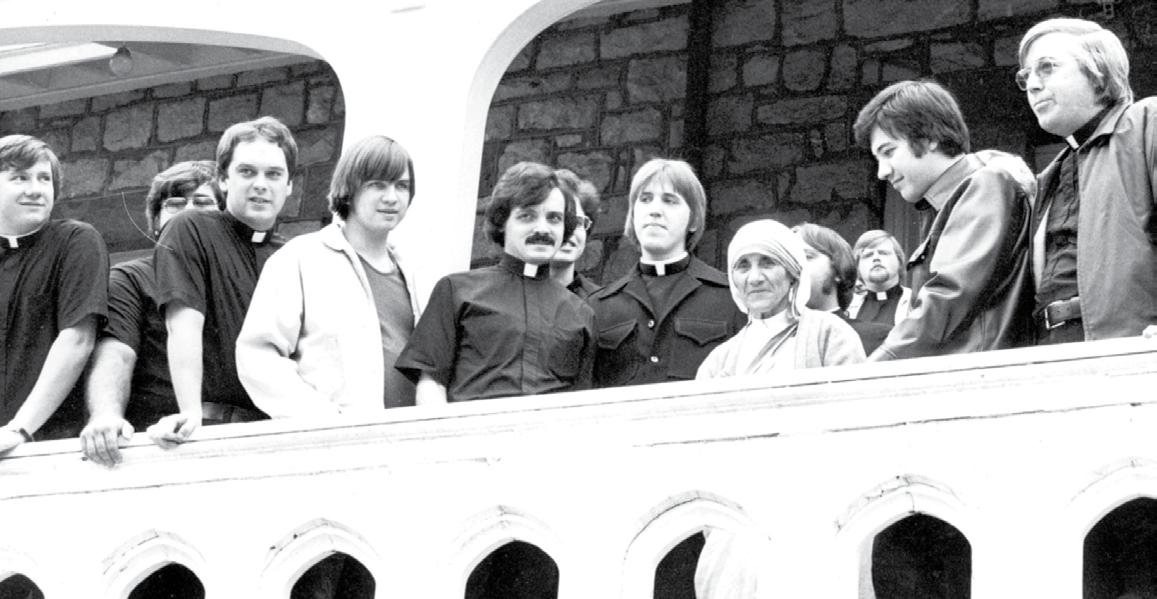
The college expanded in the post-World War II era. Women were admitted to the Mount in 1972, and a women’s basketball team was established within two years. By the late 1970s, a women’s track team competed alongside the storied men’s team, with both sexes coached by the Mount’s remarkable track and field and men’s soccer coach Jim Deegan. Deegan coached for 50 years before retiring in 2006. He remains involved with the track and field program as a volunteer and just completed his 62nd season with the team. Under Deegan’s tutelage, Peter Rono, C'92, won the gold medal in the 1500 meter run at the 1988 Olympics as only a sophomore. Other notable alumni of the 20th century are Rev. Edward Flanagan, C’06, MA’08, founder of Boys Town orphanage in Nebraska; Rory Bourke, C’64, a songwriter in the Nashville Songwriters Hall of Fame; Michael McCafferty, C’64 , an entrepreneur and “Father of CRM”; Dr. Bill Magee Jr., C’66, founder of Operation Smile; Fred Carter, C’69, a professional basketball player; Susan O’Malley, C’83, the first female president of an NBA franchise, the Washington Wizards; and Paul Palmieri, C’92, founder of Millennial Media and managing partner of Grit Capital. When Saint Teresa of Calcutta blessed the Mount with her first of two visits in 1975 to spread her message of prayer and love for Jesus Christ, Archbishop William Lori of the Archdiocese of Baltimore, S’77, then a seminarian, observed: “Mother Teresa mostly talked about the vine and the branches. She told those of us who were preparing to become priests that we should be closely connected to Jesus–that Jesus was the source of our charity, that Jesus would keep us faithful, that Jesus would give us the ability to give of ourselves. Even as callow seminarians, we sensed the wisdom of her holiness.” As the century closed, Rev. James T. Delaney, a faculty member in psychology and sociology, founded the criminal justice studies program. In 1999, Mount leaders opened a satellite campus in nearby Frederick. The Frederick campus, specializing in graduate and adult undergraduate programs, has outgrown its space several times and continues to add programs to meet the needs of Frederick County employers.
“STEWARDS OF THE MANIFOLD GRACE OF GOD” The Mount achieved university status in 2004, which began a new era of academic excellence that would usher in the university’s bicentennial in 2008. President Barack Obama came to campus in 2015 to speak at the National Fallen Firefighters Memorial Service. In addressing the importance of service, he succinctly described the Mount’s charge to today’s students: “As each one has received a special gift, employ it in serving one another as good stewards of the manifold grace of God.” Much has changed over the last 210 years, but in the spirit of our founder, Rev. John DuBois, the Mount continues to graduate ethical servant leaders. As Timothy E. Trainor, Ph.D., the Mount’s 26th president, stated in his inaugural address on October 23, 2017: “Our faculty and staff are motivated to help our students become the best version of themselves and prepare them to lead lives of significance in service to God and others….We are poised to create the success stories that will become the next 200 years of our history.” The future of Mount St. Mary's University lies within the solid foundations of its past. At the 2018 convocation ceremony to mark the start of the 2018-19 academic year, Vice President for Student Life Bernard Franklin, Ph.D., predicted early greatness for at least one of the students in Knott Arena. “I believe one of you will come to your significance soon after you leave the Mount—and we will all be amazed at your extraordinary work to God and man,” he exalted. A recent example is Nancy Abu-Bonsrah, C’12, who last year became the first African-American woman to earn a residency in neurosurgery at Johns Hopkins University School of Medicine. Other alumni who are leading lives of significance, in both big and small ways, are highlighted on pages 17-32. These extraordinary alumni are ambassadors for the university, evidence of how Mount St. Mary’s faculty, administrators and staff lift students up academically, physically and spiritually, enabling them to contribute to the betterment of society.

